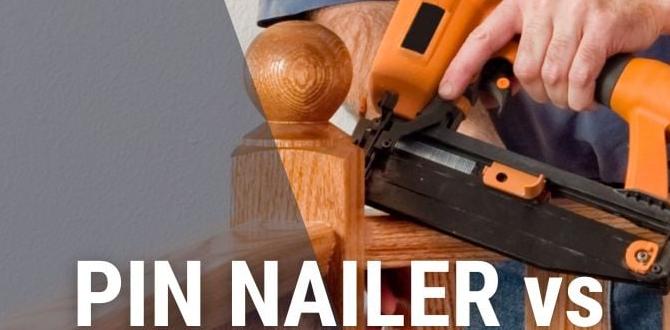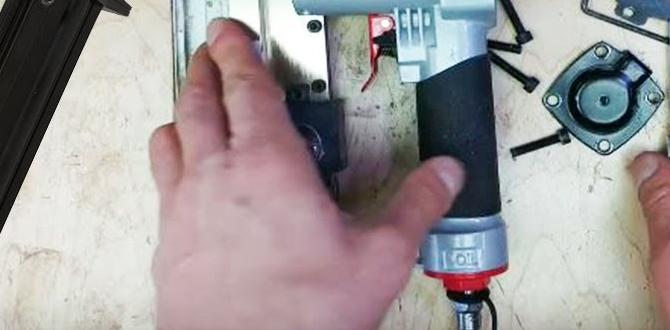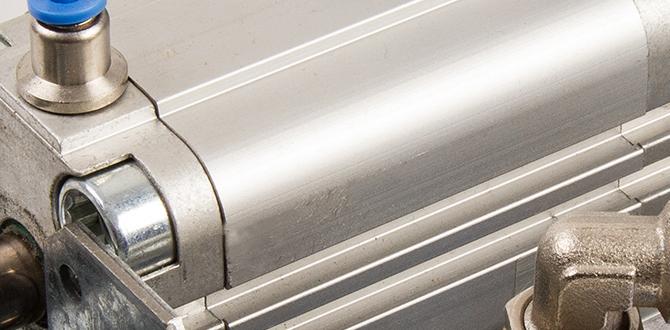Quick Summary: For finish nailing, cordless nailers offer ultimate freedom and portability. Air-powered nailers provide consistent power and lower cost but require a compressor and hose. Choose based on your project’s location and frequency of use.
Hey there, DIY enthusiasts and budding woodworkers! Jack Shaffer here, your go-to guy for all things nailing and making. Ever stare at a project – maybe building those beautiful crown moldings or attaching delicate trim – and wonder about the best nailer to use? If you’re torn between a cordless and an air-powered finish nailer, you’re not alone! It’s a common spot to be in when you’re starting out, and honestly, it can feel a bit overwhelming. But don’t you worry one bit. We’re going to break down this choice into easy, understandable pieces. By the end of this, you’ll know exactly which nailer will be your trusty sidekick for your next project. Let’s get you nailing with confidence!
Table of Contents
Cordless vs. Air-Powered Finish Nailers: Making the Smart Choice
Picking the right nailer is like choosing the right tool for any job – it makes everything smoother, faster, and way more enjoyable. Finish nailers are fantastic for that final touch, like adding decorative molding, trim work, or even building furniture where you want those nails hidden. The big question for many is: should I go with the freedom of cordless, or the tried-and-true power of air? This comparison is all about helping you understand the strengths and weaknesses of each, so you can invest in the tool that fits your needs perfectly. We’ll dive deep into what makes each type tick, so you can make an informed decision and get back to creating!
Understanding Finish Nailers
Before we compare, let’s quickly talk about what a finish nailer actually is. Unlike framing nailers that drive big, beefy nails for structural work, finish nailers are designed for smaller, thinner nails – typically 15 or 16 gauge. These nails have a smaller head that’s easier to sink below the wood surface. This makes them perfect for installing baseboards, window casings, chair rails, and other decorative trim where you want a clean, finished look. They’re all about precision and aesthetics, not brute force.
The Cordless Camp: Freedom and Portability
Cordless finish nailers are the modern marvels of the nailing world. They run on battery power, meaning no tangled hoses and no need for a bulky air compressor. This freedom is a huge draw for many DIYers.
Pros of Cordless Finish Nailers:
- Ultimate Portability: Take it anywhere! Attic, basement, backyard—no need to drag an air compressor.
- No Hoses: No tripping hazards, no wrestling with kinks, and nothing to snag on things.
- Quick Setup: Grab it, pop in a battery, and you’re ready to go.
- Great for All Skill Levels: The convenience makes them very beginner-friendly.
Cons of Cordless Finish Nailers:
- Battery Dependency: You need charged batteries. If you run out mid-project, it’s a waiting game.
- Weight: Batteries add some weight, which can be noticeable during long projects.
- Cost: Often have a higher upfront cost, especially when you factor in extra batteries.
- Power Variability (Sometimes): While modern cordless are very powerful, some older or lower-end models might struggle with very dense hardwoods.
How Cordless Finish Nailers Work
Cordless finish nailers typically use a combination of a battery-powered motor and a small, self-contained air cylinder or a spring-loaded firing mechanism. When you pull the trigger, the battery powers a mechanism (like a small fan or piston) to rapidly pressurize the air cylinder, which then drives the nail. Others use a spring system that’s compressed by the motor. This means you get consistent power for each nail without needing an external air source.
For more on how these tools are powered, you can explore resources on the U.S. Department of Energy’s research into energy efficiency in buildings, which touches on the electrical components of modern tools.
The Air-Powered Camp: Consistent Power, Classic Choice
Air-powered (or pneumatic) finish nailers have been the workhorses of the trade for decades. They rely on compressed air from an air compressor, delivered through a hose, to drive nails.
Pros of Air-Powered Finish Nailers:
- Consistent Power: They deliver strong, reliable power for every shot, regardless of battery levels or temperature.
- Lighter Tool Weight: The nailer itself is lighter because the motor and compressor are separate.
- Lower Tool Cost: The nailer itself is often less expensive than its cordless counterpart.
- No Battery Worries: As long as your compressor has air, you’re good to go.
- Great for High-Volume Work: Ideal for professionals or hobbyists tackling big jobs.
Cons of Air-Powered Finish Nailers:
- Requires an Air Compressor: This is a significant investment in both cost and space.
- Hose Management: You have to deal with an air hose, which can be cumbersome and a tripping hazard.
- Noise: Air compressors can be quite loud, and the nailer itself makes a distinct “thump.”
- Setup Time: Need to connect the hose, turn on the compressor, let it build pressure.
- Limited by Hose Length: Your reach is restricted by the length of your air hose.
How Air-Powered Finish Nailers Work
These nailers work by storing compressed air in a chamber. When you pull the trigger, a valve opens, releasing the stored air pressure behind a piston. This piston strikes the head of the nail, driving it into the material. The air compressor’s job is to constantly refill this chamber and maintain the necessary air pressure. This direct use of compressed air is what gives them their consistent, driving power.
Understanding air pressure is key for pneumatic tools. The Occupational Safety and Health Administration (OSHA) provides extensive guidelines on the safe use and maintenance of compressed air systems, which is crucial for tool longevity and user safety.
Head-to-Head: Cordless vs. Air-Powered Finish Nailers
Let’s put these two types side-by-side to really highlight their differences. This table should help you visualize where each one shines.
| Feature | Cordless Finish Nailer | Air-Powered Finish Nailer |
|---|---|---|
| Power Source | Battery (Lithium-ion) | Air Compressor via Hose |
| Portability | High – No cords or hoses | Moderate – Limited by air hose and compressor placement |
| Setup Time | Very Fast – Load battery & nails | Moderate – Connect hose, turn on compressor, wait for pressure |
| Tool Weight | Moderate to High (due to battery) | Light (nailer itself) to Heavy (with compressor) |
| Nail Firing Consistency | Very Good (modern models) | Excellent – Always consistent |
| Upfront Cost | Higher nailer cost + battery cost | Lower nailer cost, but significant compressor cost |
| Ongoing Cost | Battery replacement eventually, electricity | Electricity for compressor, air tool oil |
| Noise Level | Moderate | High (compressor is loud) |
| Suitable For | DIYers, trim work, renovations, mobile use | Professionals, high-volume work, workshops, consistent power needs |
Which One is Right for YOU? Key Considerations
Now that we’ve laid out the specs, let’s talk about how to make the decision. It really comes down to your personal woodworking habits and project needs.
Consider Your Projects:
- Location, Location, Location: Will you be working in a garage with power close by, or tackling projects on the other side of your yard? Do you need to move around a lot in a tight space?
- Frequency of Use: Are you a weekend warrior doing occasional trim work, or do you have big renovation projects planned?
- Type of Wood: While both can handle most softwoods and some hardwoods, if you frequently work with extremely dense exotic hardwoods, an air-powered nailer might offer more consistent driving power.
- Space and Storage: Do you have room for an air compressor and all its accessories?
Consider Your Budget:
Think about the total cost. A cordless nailer might seem more expensive upfront, but if you don’t need an air compressor for other tools, it could be more economical in the long run. Conversely, if you already have a compressor for inflating tires or using other air tools, an air-powered finish nailer is a very cost-effective addition.
Consider Your Workflow:
How important is speed and ease of setup to you? Cordless champions quick setup. If you value that seamless transition from opening the toolbox to driving nails five minutes later, cordless is a strong contender. If you’re in a workshop and don’t mind a few minutes of setup for dependable, powerful results, pneumatic is great.
When a Cordless Finish Nailer is Your Best Friend
If you’re nodding along to these points, a cordless finish nailer might be your perfect match:
- You value the freedom to move around your project without being tethered.
- You often work in locations without easy power access.
- You want the quickest possible setup and cleanup.
- You’re tackling trim work, furniture assembly, or decorative projects around the house.
- You’re a beginner looking for a user-friendly tool that reduces complexity.
- You need to work in tight spaces where a hose would be a nuisance.
Many manufacturers like DeWalt, Ryobi, and Milwaukee offer excellent cordless finish nailers with impressive features. Battery platforms are a big deal here – if you already own other tools from a specific brand, their cordless nailer will likely use the same batteries, saving you money.
When an Air-Powered Finish Nailer is Your Go-To Choice
On the other hand, an air-powered finish nailer could be the ideal tool if:
- You need that rock-solid, consistent power for every single nail, every time.
- You’re working on large-scale trim jobs or in a professional capacity.
- You already own an air compressor and want to leverage that investment.
- You need a lighter nailer in hand for extended periods.
- You’re on a tighter budget for the nailer itself, and the compressor cost is already covered or not a factor.
- You work mostly from a workshop or a fixed location.
Popular brands for reliable air-powered finish nailers include Paslode, Senco, and Porter-Cable. These have been industry standards for years due to their durability and performance.
Making the Connection: Hoses and Compressors
If you lean towards the air-powered option, choosing the right compressor and hose is important. A good rule of thumb is to get a compressor with a tank size that can keep up with your nailer’s demand. For finish nailers, a smaller compressor (around 2-6 gallons) is often sufficient, but it should deliver at least 2.1 CFM (Cubic Feet per Minute) at 90 PSI (Pounds per Square Inch), which is the standard operating pressure for most finish nailers. The air hose needs to be rated for the pressure your compressor provides and be long enough to comfortably reach your work area without pulling. Look for braided hoses for durability.
To understand compressor specifications better, resources like those from tool forums or manufacturer guides often detail CFM requirements for different tools.
Essential Accessories for Both Types
No matter which nailer you choose, some accessories are crucial for a good experience:
For Cordless:
- Extra Batteries: Essential for longer projects to avoid downtime.
- Charger: Obviously!
- Nails: Make sure you buy the correct gauge and length for your nailer and project.
- Safety Glasses: Non-negotiable for eye protection.
- Hearing Protection: While often quieter than air nailers, some still produce significant noise.
For Air-Powered:
- Air Compressor: The heart of the system.
- Air Hose: At least 25 feet, often 50 feet.
- Air Tool Oil: For lubricating the internal parts of pneumatic tools.
- Nipples/Couplers: To connect the hose to the nailer and compressor.
- Nails
- Safety Glasses
- Hearing Protection
- In-line Regulator: To fine-tune air pressure for different woods or nail types.
Safety First! Always.
This is the most important part. Nailers are powerful tools, and safety should always be your top priority. Always wear safety glasses. Never point a nailer at yourself or anyone else. Keep your fingers away from the trigger and the nose of the tool when not actively firing. Understand how your specific nailer’s safety features work – most have a contact tip that must be pressed against the wood before the nail will fire (often called “contact actuation” or “sequential actuation”). Learn about the different actuation modes and use the one that best fits your task and safety needs. The Consumer Product Safety Commission (CPSC) offers valuable information on nail gun safety.
Frequently Asked Questions (FAQ)
Q1: Can a cordless finish nailer drive nails into hardwood just as well as an air-powered one?
A1: Modern high-quality cordless finish nailers, especially those with lithium-ion batteries and advanced motor technology, can drive into most hardwoods effectively. However, for extremely dense hardwoods or for very high-volume work where consistent power is paramount, an air-powered nailer might still have a slight edge in raw driving force and consistency.
Q2: What’s the biggest advantage of using a cordless finish nailer?
A2: The biggest advantage is definitely its portability and freedom. You can take it anywhere without worrying about air hoses or compressors, making setup incredibly fast and ideal for jobs in tight spaces or remote locations.
Q3: Is an air-powered finish nailer always more powerful?
A3: While air-powered nailers offer consistent, robust power, newer cordless models are very powerful too. The difference often lies in consistency over long periods or when tackling exceptionally hard materials. Think of it as a very powerful, steady stream of air for pneumatic vs. a very strong, but potentially slightly less consistent, burst for cordless.
Q4: How much does a typical cordless finish nailer setup cost compared to an air-powered setup?
A4: A good cordless finish nailer (tool only) can range from $150-$300, but you’ll need batteries and a charger, adding $50-$100+. An air-powered finish nailer might cost $100-$200, but you’ll need an air compressor (starting around $100-$200 for a basic but capable one) plus a hose and fittings ($50-$100). So, the initial investment for cordless can be similar or slightly higher than basic air, but a sophisticated cordless setup can be more. If you already have a compressor, air is cheaper for the nailer.
Q5: Do I need special maintenance for each type?
A5: Yes. Cordless nailers require keeping batteries charged and clean. Air-powered nailers need regular lubrication with air tool oil, and the air compressor system needs proper draining of moisture. Always follow the manufacturer’s specific maintenance guidelines.
Q6: Which type is quieter?
A6: Generally, cordless finish nailers are quieter than air-powered nailers. The main noise from an air nailer comes from the exhaust port releasing air with each shot, and the compressor itself is a significant source of noise when running.
Conclusion: Your Next Project Awaits!
So, there you have it! We’ve compared cordless vs. air-powered finish nailers, looking at their strengths, weaknesses, and what makes each one tick. You’ve learned about the incredible freedom that cordless models offer for portability and quick setups, making them a dream for DIYers on the go or working in intricate spaces. You’ve also seen why air-powered nailers remain a staple with their consistent, deep power, perfect for high-demand jobs or when you’re already invested in an air compressor system.
The “genius” comparison comes down to matching the tool to your specific needs. If you




